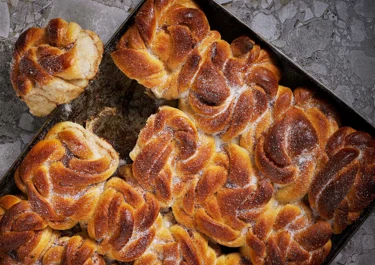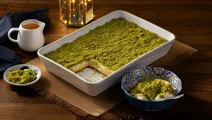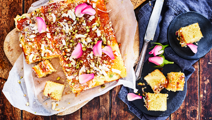Cinnamon buns in a pan

Incredibly moist cinnamon buns made in a long baking dish and baked full of flavour. A simple recipe with a tasty, creamy filling. Alternatively, use the same dough to bake one giant roll in a round dish to create a cinnamon bun cake! This cinnamon bun recipe is perfect for parties or just a coffee break.
Ingredients
Cinnamon roll
|
25 g
Yeast
|
|
|---|---|
|
50 g
Butter
|
|
|
250 ml
Arla Cravendale Whole milk
|
|
|
125 g
Quark
|
|
|
90 g
Caster sugar
|
|
|
1 pinch
Salt
|
|
|
450 g
Plain flour
|
Filling
|
100 g
Butter (room temperature)
|
|
|---|---|
|
45 g
Caster sugar
|
|
|
½ tbsp
Ground cinnamon
|
Decoration
|
1
Egg
|
|
|---|---|
|
25 g
Butter
|
|
|
3 tbsp
Caster sugar
|
Instructions
Step 1
Step 2
Step 3
Step 4
Recommended information
Serving suggestion
Questions about cinnamon buns in a pan
These sweet and juicy cinnamon buns in a pan are a delicious treat, perfect for any occasion. Read below to find out more about them.
How do you keep cinnamon rolls from sticking to the pan?
The simple answer is don’t skip on properly greasing your oven proof dish, otherwise there’s a high chance of the buns sticking while baking. Using waxed oven paper is also extra helpful.
Is it better to bake cinnamon rolls in a glass or metal dish?
While both a metal and a glass dish will work just fine, the glass will retain heat better and also avoids the risk of the buns reacting with the metal to alter their flavour.
Why are my cinnamon rolls not fluffy?
If not enough air gets into the dough during the kneading and rising process the result will be a flat, lifeless bun. Make sure the yeast you use hasn’t expired, and as a guide check the dough has doubled in size from when it was first mixed until it is ready to be put in the oven. Other factors that can prevent the yeast from activating properly include being baked in a cold room or the liquid added to it being too hot.
Should you roll cinnamon rolls tight?
It can be tempting to roll the buns until they’re tight, but the goal is to allow enough room for the layers to expand and bake evenly through to the middle. Try to achieve a balance between rolling gently but not too loose.
What happens if you knead cinnamon roll dough too much?
There is definitely such a thing as too much kneading. Doing so makes the flour tough and ruins the end product. Only knead the dough until it is smooth, shiny and elastic.
The evolution of cinnamon buns – from rare treat to beloved staple
The modern Swedish variety of cinnamon bun featured in this recipe has its origins in the 1920s. When items rationed during the First World War finally came back in stock, ingredients like butter, sugar, flour and cinnamon became hot commodities. People were drawn to cafés where they could once more order a cinnamon bun with their coffee, and bakeries started taking orders for the treats. The popularity of the sweet treats grew rapidly from there.
Try cream cheese frosting for extra flavour
A common feature of the variety of cinnamon bun sold in the US is cream cheese frosting, and combining that topping with the Swedish classic creates a mouth-watering alternative. Simply mix cream cheese, butter, sugar and powdered cinnamon until fully blended. Once you have a smooth and fluffy consistency, add it to the top of the warm cinnamon bun and serve.
The classic Swedish fika
Cinnamon buns are a staple of fika – the Swedish custom of having a coffee break with something sweet on the side. Other common variants include buns using cardamom along with the cinnamon, or even more luxurious saffron buns during the Christmas season.
Freeze them for later
Once the buns have been allowed to cool at room temperature, they can be frozen, defrosted then later quickly re-heated at a low temperature to soften up. It can also be a good idea to wait until defrosting before adding the sugar and butter topping to create the freshest flavour possible.









